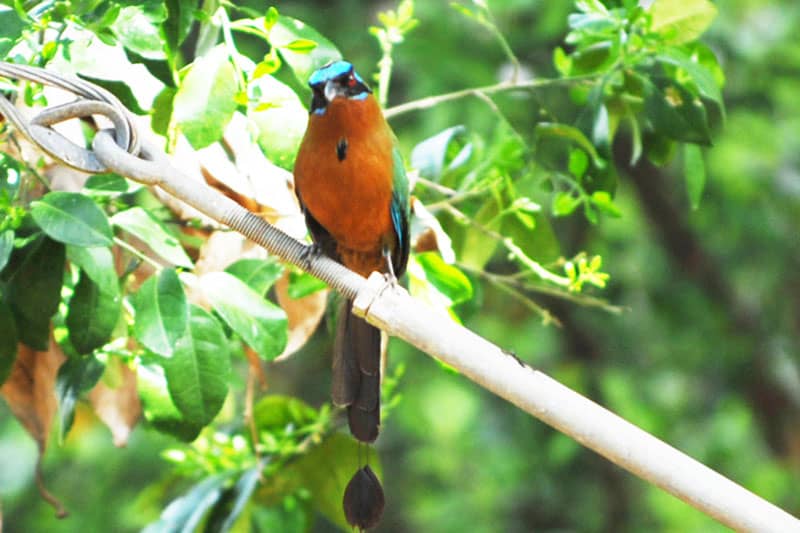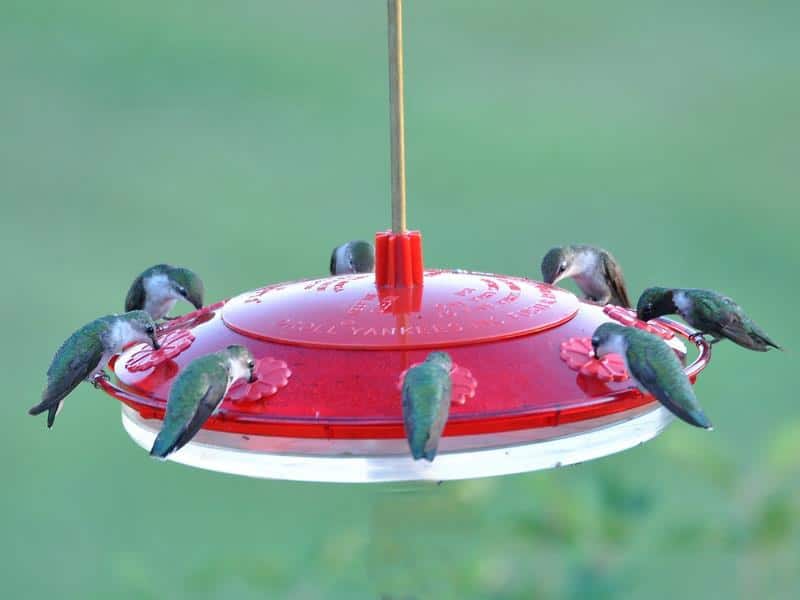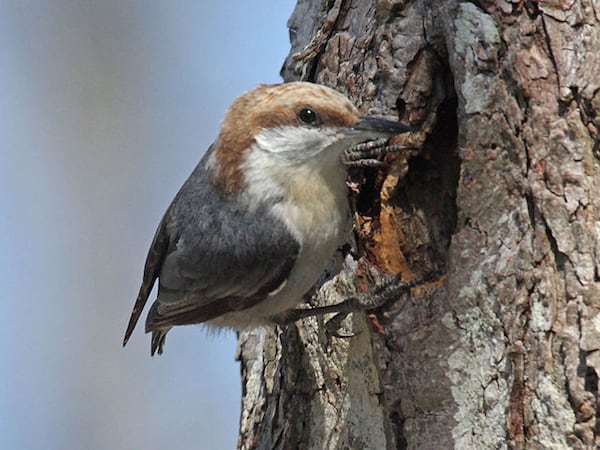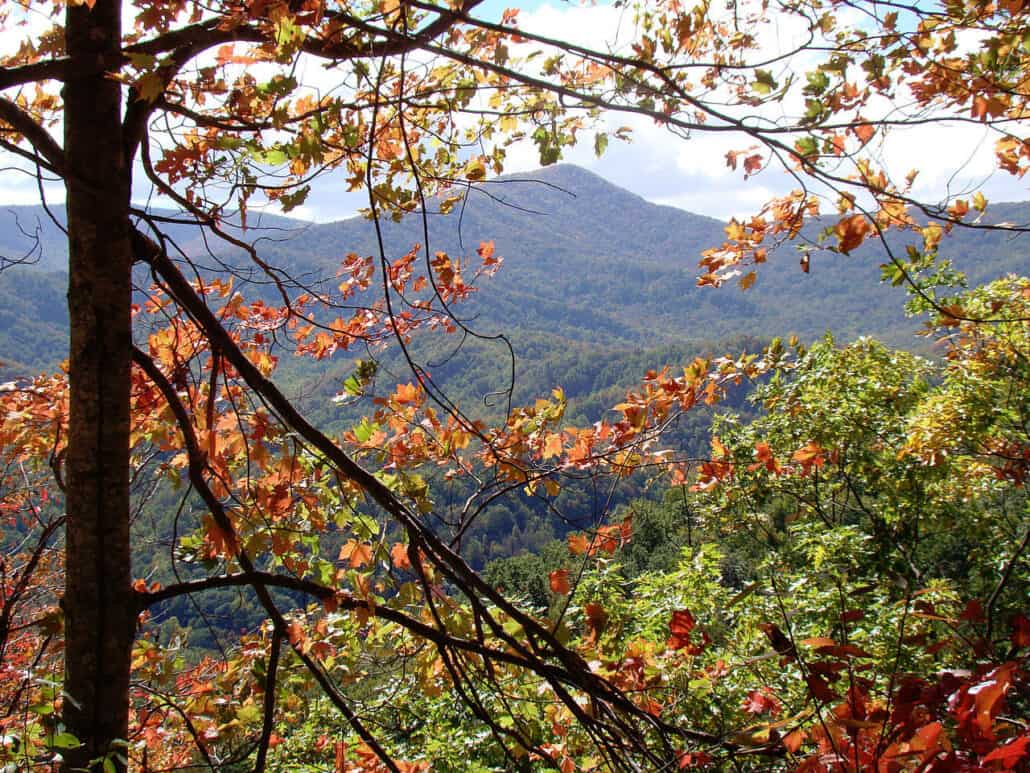Introduction to the Neotropics—a Winter Trip to Trinidad and Tobago
Introduction
Wake up to the calls of barred antshrikes, ferruginous pygmy-owls, blue-crowned motmots. Step out onto the porch of your cabin and see a male tufted coquette and silver-beaked tanager in the treetop. Then make your way to the veranda to view the early morning feeder frenzy—white-necked jacobins, honeycreepers, several other species of hummingbirds and tanagers, and innumerable bananaquits. Watch ruddy ground-doves and red-rumped agoutis on the ground below the feeding tables. Look through a scope and see crested oropendolas and a channel-billed toucan. Hear bearded bellbirds calling from the forest below.
By now you’ve probably guessed the location: Asa Wright Nature Center in the Arima Valley in Trinidad. And all this was before 7 a.m. on our first day.
This was Bob’s and my first trip to the neotropics, so nearly all the birds were new to us. We had studied ahead of time, using the helpful A Guide to the Birds of Trinidad and Tobago by Richard ffrench. Initially, we had the difficulty that birders new to an area often experience: having no idea how to think about birds with names like “jacamar,” “dacnis,” or “euphonia.” Should we be thinking “waterfowl,” “raptor,” “hummingbird”? Of course the index helped, and gradually we arrived at a working knowledge of these birds.
We were met at Piarco International Airport, southeast of the capital, Port-of-Spain, by Dave Ramlal, who also served as our birding guide while we were on Trinidad. The center at Asa Wright has a number of qualified guides like Ramlal, who assist independent travelers and serve as auxiliary local leaders with organized tours.
After collecting our luggage, we left the airport on the Churchill-Roosevelt Highway and drove along a winding road, heading northeast up into the mountains to Asa Wright. (This road, according to Dave, who has driven it many times, has 124 turns.) On the way Dave narrated the history, geography, and demography of the island.
In 1962, Trinidad and Tobago gained their independence from the British West Indies Federation. Historically, major Trinidadian crops have been cacao and sugarcane. There are a few oil refineries in the south. Over the years, witchbroom, an invasive species, has severely cut the production of cacao. After slavery was abolished, workers were recruited from India, brought to Trinidad, and indentured for five years to keep the sugar plantations going. Currently there are as many Indians as ethnic Africans in the general population. Hundreds of Hindu temples dot the countryside.
By the time we arrived at Asa Wright (it took about an hour ) it was about 11:30 p.m. Little sandwiches and a pot of tea welcomed us in our cabin on the hillside.
At dawn the next day we walked down to the veranda, where some folks had already gathered. Juggling binoculars and cups of coffee, we perched at the railing and watched the birds as they fed. It was almost too much to take in. Copper-rumped and white-chested emerald hummingbirds competed for feeder space. Bananaquits did their best to monopolize the feeding trays, but did leave room for palm, silver-beaked, blue-gray, and white-lined tanagers, as well as green hermits. The center staff had a scope set up and people took turns looking at the more distant birds. Just before the breakfast bell rang, a large flock of lilac-tailed parrotlets came screaming in.
After breakfast several of us guests walked down a trail to see one of the island’s main attractions: oilbirds. Because of the oilbirds’ endangered status, access to them is possible only with a guide from the center. Historically, these birds have been captured and boiled down to provide oil for cooking and lighting. Now their survival depends of the protection they receive in sanctuaries such as Asa Wright.
On the way down the hill to the oilbird cave we spotted a gray-throated leaftosser, nearly entirely camouflaged as it scratched at the vegetation beneath one of the trees. A violaceous trogon perched high in a tree. Along the trail were plain brown and cocoa woodcreepers foraging in the trees. We heard a bird that sounded a lot like an American robin, and discovered that it was a cocoa thrush.
Because the island had recently had an unusual amount of rain, the steep trail to the cave was very muddy and slippery, and many of us made use of the handrail. It was dark inside the cave, but the guide had brought along a flashlight, which he used to find the oilbirds. Their red eyes reflected back at us.
Oilbirds are large rusty-brown, nightjar-like birds, with huge eyes and wide gapes. They are one of only two groups of birds, the other being cave swiftlets, that are known to use echolocation to navigate in the dark caves in which they nest.
Caroni Swamp
After lunch at the center, we were driven to Caroni Swamp, noted for its scarlet ibis roost. On the way at a sewage pond was an assortment of birds in and around the water, including wattled jacana, southern lapwing, and purple gallinule. In the reeds were pied water-tyrant, white-headed marsh tyrant, red-capped cardinal, and blue-black grassquit. A fork-tailed flycatcher flew overhead.
It had begun to rain by the time we arrived at the boat ramp, where a flat-bottomed boat awaited to take us out to see the ibises. As it turned out, Bob and I, plus a local college student, were the only passengers that afternoon. The boat was equipped with a tarpaulin, but because of the low-hanging mangroves, it could not be deployed until we were out in open water. Fortunately, Bob and I had brought umbrellas, absolutely essential in the tropics, and we made good use of them.
However, the tide was high that afternoon, so there was not a great deal of bird life on the way out except for an occasional scarlet ibis. We did see a few turtles and a very large snake coiled around a tree branch.
Out in open water, across from the ibis roosting spot, the captain put the tarpaulin up, and we were all somewhat sheltered under it. As we started to lose light, numbers of great egrets came in to the roost, and soon the trees were speckled with white. Rum punch appeared on schedule, and while we sipped our drinks, the scarlet ibises began to appear in numbers. Soon, as more and more flew in, the trees became covered with red. It was a spectacular sight.
It was dark by the time we got back to the dock, thoroughly soaked and a little bit chilly, but still feeling awed by the beauty of the spectacle we had just witnessed.
After dinner, the center staff showed a video of Trinidad’s Carnival that explained the cultural and religious significance of the annual event. Similar to New Orleans’s Mardi Gras, Carnival came to Trinidad in the 1780s with the arrival of French immigrants. Held in Port of Spain, Carnival is a five-day pageant leading up to Ash Wednesday. Its unifying principle is the Holy Trinity, for which Trinidad is named. Elaborate costumes, parades, and steel bands make for a festive occasion.
Aripo Savanna
On the following day, Dave took us to the Aripo Savanna to look for grassland birds. The first bird spotted there was a savanna hawk, perched on a tall pole. Other birds in that area were striated heron, which looks quite similar to our green heron; a striped cuckoo, perched on a nearby reed; and a gray kingbird. Some odd-looking cattle in a rather distant field were pointed out as “buffalypsos,” an experimental cross between water buffalo and Black Angus cattle.
Stopping to bird along some back roads we found the tiny violaceous euphonia, which Bob nicknamed “the Cub Scout bird” because of its dark blue and bright yellow coloration. Also seen were sooty grassquit, forest and yellow-billed elaenia, streaked xenops, and rufous-browed peppershrike.
Dave had brought lunch, packed by the staff at Asa Wright, and we perched on a low wall beneath the overhang of an abandoned store and ate while watching military exercises at the nearby wooded proving grounds. We got good looks at bay-headed tanager, golden-headed manakin, and green honeycreeper in the trees across the road.
Later we stopped at a roadside store and noted that there were baglike yellow-rumped cacique nests in the trees across the road. We watched the caciques, black birds with yellow rump, wing patch, and undertail, flying in and out of the nests.
Back at the center in the early afternoon, we joined the others who had gathered on the veranda to sip tea and scan the trees for parrots, woodpeckers, and flycatchers. A great kiskadee perched obligingly.
Night Birding: Waller Field
That evening Dave, accompanied by a security guard, picked us up for a night bird expedition. This was the first indication that there could be some risk in traveling around the island, especially at night. We headed for Waller Field, an abandoned military airfield, owned by the U.S. government since World War II. Abandoned after the war, it is a vestige of FDR’s Lend Lease Program, originally built as a waystation for bombers on their way to Africa. While waiting for it to get dark, we scanned the trees and brushy areas and found sulfury flycatcher, savanna hawk, semipalmated plover, and band-rumped swift.
Dave had brought dinner, and as night fell, set out our rather elegant repast on a platform just across one of the runways from a racecar track viewing stand. He explained that Waller Field serves as a venue for regular car races.
When it was finally dark, our serious search for night birds began. A barn owl flew across our path and settled on a post. Dave shone his light beam around, looking for eyeshine, and soon we got great looks at white-tailed nightjar and pauraque, a large long-tailed nightjar. Driving around the periphery of the field, we flushed many more nightjars. We finally found a common potoo perched in a tree, its yellow eyes staring at us.
We returned to the center in time for the evening video, which featured the abundant wildlife around Asa Wright—white-bearded manakins on a lek, oilbirds, bellbirds, and others.
Blanchisseuse
We’d signed up to be taken to Blanchisseuse on the north coast of the island on the following day. The town got its name from the time when women used to take their washing to the rocks at the beach there. The rides to and from the coast were interesting. For one thing, the heavy rains had caused many mudslides along the road, and there was much evidence of the work of road crews who had been busy clearing away fallen trees, debris, and mud. It rained off and on all day. By this time we had become adept at managing binoculars and umbrellas.
We saw maybe 30 bird species on the way to and from Blanchisseuse: a pair of bat falcons perched in a tree, seen well through a scope; jacamar, with its sharp, straight bill; violaceous, collared, and white-tailed trogons; boat-billed flycatcher; blue-chinned sapphire hummingbird; and black-tailed tityra, a rather aggressive cotinga commonly found on forest edges.
We had lunch under a shelter on the beach at Blanchisseuse and took a walk afterward, while dodging raindrops. Spotted sandpipers, old friends from home, were at the water’s edge.
Nariva Swamp
No birding trip to Trinidad is complete without a visit to Nariva Swamp, located midway along the eastern edge of the island. Some highlights there were black-bellied whistling ducks and limpkin, two ospreys, and a colony of yellow-rumped caciques. As we watched a lineated woodpecker fly away, we saw a red howler monkey with a baby on its back, high in a tree. Several common black-hawks roosted in nearby trees. We made a stop for black-crested antshrike, a much sought after bird, and finally found a pair nearly buried in the vegetation.
At the so-called “melon patch” at Nariva was a small group of giant cowbirds, one yellow-hooded blackbird, and two pinnated bitterns, as well as a few purple gallinules. A group of yellow-crowned parrots flew into some nearby vegetation, spectacular in perfect light. Then it was time to go to watch the red-bellied macaws come in to roost. A number of macaws were already in the trees, and groups were still coming in.
Off to Tobago
After breakfast the following morning we said a reluctant goodbye to Asa Wright and left with Dave for the airport to continue our birding adventure on Tobago. Because we had missed seeing ferruginous pygmy-owl and pearl kite, Dave promised to help us find them on our last morning, so we stopped along the road not far from Asa Wright. Undaunted by the rain that was coming down in buckets (and with some help from Dave’s father Roodal, who was leading another group) we got a great look at the owl. Later we stopped on a back road and found a pearl kite, a tiny raptor.
After a 20-minute flight we were met by a driver named Jim, who drove us to Blue Waters Inn on the east side of Tobago. The roads were in really bad shape after all the rain. Again, there were many mudslides, and in one place, in the middle of a town, the entire road had caved in and we had to take a short detour.
We checked in and got settled into our room, which had a little terrace that faced the Atlantic Ocean. During lunch at the Blue Waters restaurant, blue-crowned motmots entertained us. We walked around the grounds afterward and found rufous-vented chachalacas strolling about the lawn, many bananaquits at the feeders, male and female barred antshrikes working the shrubbery, and numerous assorted tanagers in the trees. Several ruddy turnstones foraged along the beach, a couple of them with leg bands.
A couple of young British birders whom we’d met at Asa Wright were just returning from a day of birding the Tobago rainforest with a local guide named Newton George. They praised his birding skills, so we corralled Newton in the bar and signed him up for a trip to Gilpin Trace in the rainforest on Sunday.
Birds of Little Tobago
The next morning, along with a group of divers, we took a glass-bottomed boat trip out to Little Tobago. Because of the rains, the water was pretty muddy, and we couldn’t see much. The first bird we encountered on Little Tobago was a chicken, foraging under a bush. But then we hiked to an overlook and had a wonderful view of Tobago, with good looks at red-billed and white-tailed tropicbirds, as well as brown and red-footed boobies and magnificent frigatebirds as they flew back and forth below us. We saw one Audubon’s shearwater, and even got a look at a shearwater’s nest hole.
Gilpin Trace
After an early breakfast the following day, we met Newton, who drove us and five other people to Gilpin Trace in the rainforest. We trudged through deep, clayey mud for several hours and accumulated an amazing number of species including several Tobago specialties—birds not found on Trinidad, such as white-tailed sabrewing hummingbird; olivaceous woodcreeper, with chestnut wings and long tail; red-crowned woodpecker, somewhat reminiscent of golden-fronted woodpecker; and stripe-breasted spinetail, a small reddish brown bird. Newton was happy to help us find a Tobago specialty, a blue-backed manakin, a tiny bird with sky-blue mantle, red crown, and orange legs.
The following day we left for the long trip home. We spent a lot of time in airports and in the air that day, but the time was used to review what we’d seen and reminisce about our amazing experiences. Trinidad and Tobago are a wonderful introduction to the neotropics, and left us itching to go back.
If You Go
- Check with your doctor about inoculations. We were advised to get hepatitis A and yellow fever shots.
- Allow yourself as much time as possible. We were away nine days, but two weeks would have been better. There’s much to see and learn there, especially if you’re new to the neotropics.




